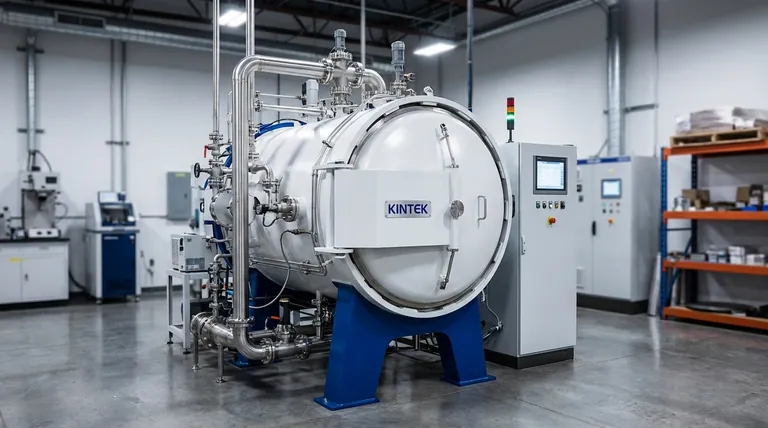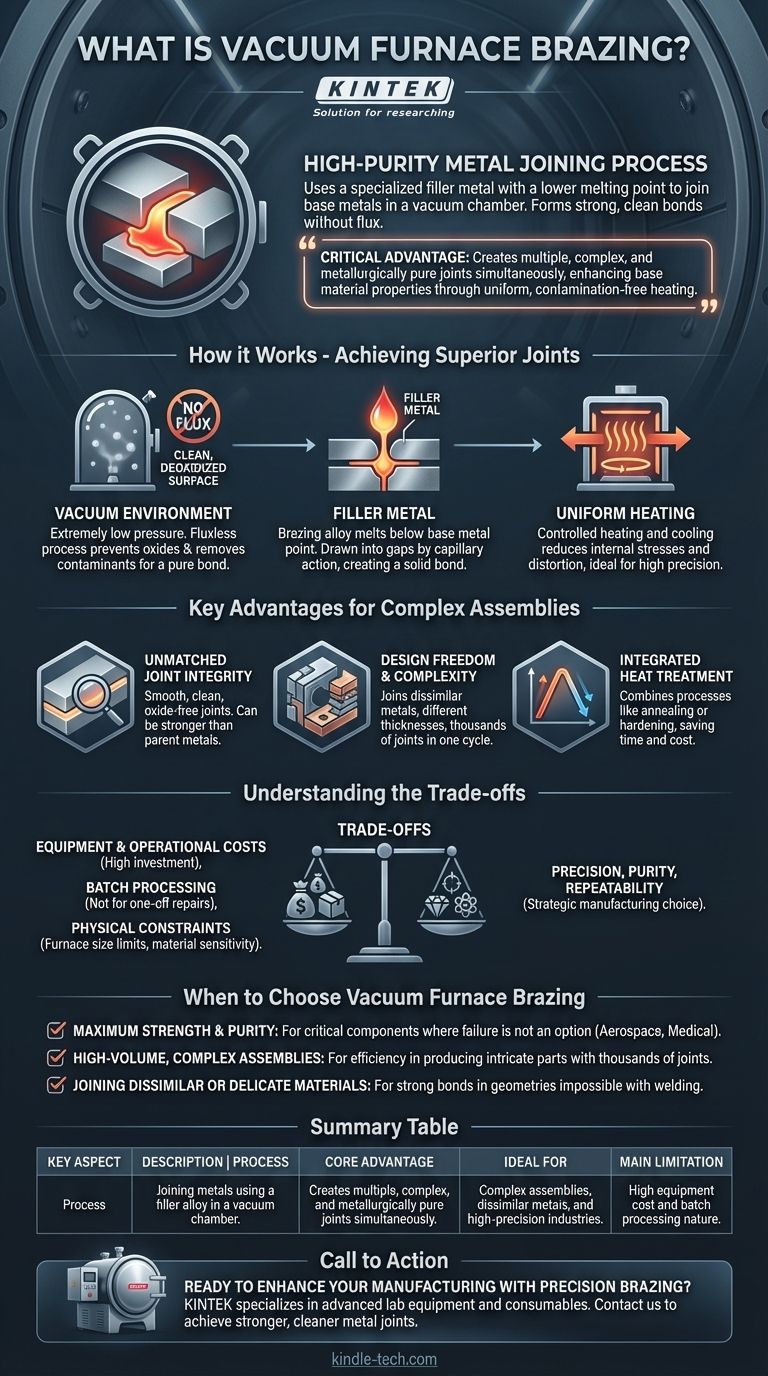At its core, vacuum furnace brazing is a high-purity metal joining process. It uses a specialized filler metal with a lower melting point to join two or more base metal components inside a vacuum chamber. The entire assembly is heated uniformly, causing the filler metal to melt, flow into the joints via capillary action, and form exceptionally strong, clean bonds upon cooling without the need for chemical flux.
The critical advantage of vacuum furnace brazing isn't just about joining parts; it's the ability to create multiple, complex, and metallurgically pure joints simultaneously, all while enhancing the properties of the base materials through precise, uniform heating in a contamination-free environment.

How the Process Achieves Superior Joints
To understand the value of this method, you must appreciate how its two core components—the vacuum and the furnace—work together to create a result that is often impossible with other techniques.
The Role of the Vacuum Environment
The process takes place at extremely low pressures, and this vacuum is an active participant, not just a passive setting. It creates a fluxless process, meaning no corrosive chemical flux is needed to clean the metals.
The vacuum itself prevents the formation of oxides that would otherwise contaminate the joint when heated. It also removes other surface contaminants, effectively deoxidizing the metals and ensuring a pure, metallurgically sound bond.
The Function of the Filler Metal
A specific brazing alloy, or filler metal, is chosen with a melting point below that of the components being joined. This is a critical distinction from welding, as the parent metals are never melted.
As the furnace heats the entire assembly, the filler metal liquefies and is drawn into the tight gaps between the components through capillary action. It diffuses slightly into the base metals, creating a solid, permanent bond as it cools and solidifies.
The Impact of Uniform Heating
Using a furnace to heat the entire assembly at once ensures temperature uniformity. This controlled heating and cooling cycle drastically reduces the internal stresses and distortion common with localized heating methods like torch brazing or welding.
This makes vacuum furnace brazing ideal for high-precision assemblies where maintaining tight tolerances is non-negotiable.
Key Advantages for Complex Assemblies
The unique environment and method of vacuum furnace brazing deliver several powerful benefits, especially for demanding applications in aerospace, medical, and high-performance industries.
Unmatched Joint Integrity
The resulting joints are smooth, clean, and free of the oxides and flux residues that can compromise the strength and lifespan of a connection. In many cases, a properly designed brazed joint can be stronger than the parent metals themselves.
Design Freedom and Complexity
This method excels where other processes fail. It allows for the joining of dissimilar metals, different material thicknesses, and the creation of thousands of joints in a single furnace cycle.
It is particularly well-suited for manufacturing delicate or intricate assemblies that would be distorted or damaged by other joining methods.
Integrated Heat Treatment
The brazing cycle's controlled heating and cooling can be designed to do double duty. Processes like annealing or hardening can be combined directly with the brazing operation, saving significant time and cost by eliminating separate post-processing steps.
Understanding the Trade-offs
While powerful, vacuum furnace brazing is a specialized industrial process with specific constraints that make it unsuitable for every application.
Equipment and Operational Costs
A vacuum furnace represents a significant capital investment. The process requires precise control systems and skilled operators, making it more costly for simple, low-volume jobs compared to manual methods.
Batch Processing and Cycle Times
This is not an instant process. A full cycle involves loading, pumping down the vacuum, heating to temperature, soaking, cooling, and unloading. This batch-oriented nature means it is less suited for rapid, one-off repairs and better for planned production runs.
Physical and Material Constraints
The size of the components is fundamentally limited by the dimensions of the furnace chamber. Additionally, the base metals must be able to withstand the brazing temperature without suffering negative metallurgical changes that would compromise their performance.
When to Choose Vacuum Furnace Brazing
Your decision to use this process should be guided by the specific demands of your project.
- If your primary focus is maximum strength and purity: This is the ideal choice for critical components where joint failure is not an option, such as in aerospace or medical device manufacturing.
- If your primary focus is high-volume, complex assemblies: The ability to create thousands of clean, repeatable joints at once offers unmatched efficiency for producing intricate parts.
- If your primary focus is joining dissimilar or delicate materials: The uniform, controlled heating allows you to create strong bonds between materials or in geometries that would be impossible with welding.
Ultimately, vacuum furnace brazing is a strategic manufacturing choice that prioritizes precision, purity, and repeatability above all else.
Summary Table:
| Key Aspect | Description |
|---|---|
| Process | Joining metals using a filler alloy in a vacuum chamber. |
| Core Advantage | Creates multiple, complex, and metallurgically pure joints simultaneously. |
| Ideal For | Complex assemblies, dissimilar metals, and high-precision industries. |
| Main Limitation | High equipment cost and batch processing nature. |
Ready to enhance your manufacturing with precision brazing?
KINTEK specializes in providing the advanced lab equipment and consumables needed for processes like vacuum furnace brazing. Our solutions help laboratories in aerospace, medical, and high-performance industries achieve stronger, cleaner, and more reliable metal joints.
Contact us today via our Contact Form to discuss how our expertise can support your specific laboratory needs and drive your projects forward.
Visual Guide

Related Products
- Vacuum Heat Treat Sintering Brazing Furnace
- Molybdenum Vacuum Heat Treat Furnace
- 2200 ℃ Tungsten Vacuum Heat Treat and Sintering Furnace
- 2200 ℃ Graphite Vacuum Heat Treat Furnace
- Vacuum Heat Treat Furnace with Ceramic Fiber Liner
People Also Ask
- What are the different types of brazing welding? A Guide to Choosing the Right Heat Source
- What is the cost of a vacuum brazing furnace? A guide to key factors and investment strategy
- What are vacuum furnaces used for? Unlock Ultimate Material Purity and Performance
- What is the process of a vacuum furnace? Achieve Purity and Precision in High-Temp Processing
- What is the difference between welding and vacuum brazing? Choose the Right Joining Method for Your Project



















